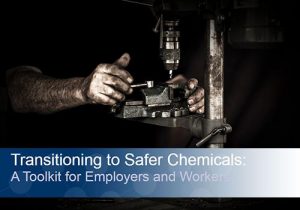Safer Chemicals For Workplaces
OSHA recently released a new toolkit to help employers choose safer chemicals and alternatives for their work sites. The agency acknowledged that there are still many harmful, yet unregulated, chemicals currently in use. Hazardous chemicals cause around 190,000 illnesses and 50,000 worker deaths each year. Chemical exposure has been linked to cancer, as well as many other debilitating diseases.
Every employer should aim to establish a chemical management system, especially in industries where chemicals are prevalent. OSHA’s toolkit aims to simplify the seemingly complex process of identifying hazards and selecting alternative chemicals.
(Related Article: Barrel Plants Face $128,000 in fines for Exposing Untrained Workers to Hazardous Chemicals)
Here is a quick breakdown of OSHA’s step-by-step guide:
Step 1: Engage
Form a Team to Develop a Plan
OSHA recommends beginning by selecting the team members who will be in charge of your chemical management system. It’s important that the team has a comprehensive understanding of your industry and day-to-day operations, so choose workers from different jobs within your workplace. Also, be sure to involve external stakeholders in your planning process.
(Related Article: Are You Forgetting This Key Part to the Respirator Standard?)
Step 2: Inventory & Prioritize
Examine Current Chemical Use
In order to identify which chemicals you need to substitute, your team should examine current chemical use and what hazards are associated with each.
Step 3: Identify
Identify Alternatives
This step will help you discover safer and more sustainable chemical solutions. Start by doing research in your industry to see examples of what has been substituted before.
Step 4: Assess & Compare
Assess and Compare Alternatives
This step will help you and your team compare each alternative by hazard, cost, and performance. This is where you will get the information that can inform your decisions.
Step 5: Select
Select a Safer Alternative
After weighing the pros and cons of different alternatives, you will need to organize this information. Evaluate potential trade-offs and select an alternative that will improve the safety and health of your workers.
Step 6: Test
Pilot the Alternative
Make the transition to the new solution on a smaller scale. This will help you plan the technical and organizational changes that will be needed. Test and evaluate the changes to identify successes and failures, as well as recognize any possible long-term impacts.
Step 7: Evaluate
Implement and Evaluate the Alternative
Finally, during this step you will implement the alternative chemical in full-scale across your workplace. Continuously monitor any effects and work to improve the process.
Another important part of a chemical management system is medical surveillance. Your employees should be routinely tested for exposure and other health impacts. Worksite Medical brings the lab to you, so you can make sure your employees are safe and healthy without missing a day of work. Learn more about our services or give us a call at 1-844-OCCUMED to schedule your visit today.




